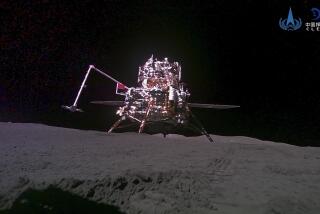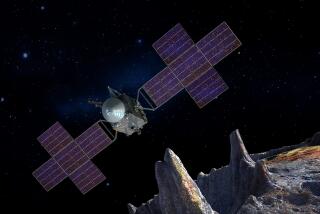UC Scientists Try to Pry Secrets Out of Rocks Picked Up on Moon
- Share via
For maybe 4.4 billion years, the 850 pounds of rocks and soil had remained undisturbed on the lunar surface.
Then, Apollo astronauts gathered up the rocks between 1969 and 1973 and brought them to Earth.
For the last 20 years, 75 to 100 scientific groups around the world have put their best minds and equipment to work unraveling the secrets locked within the precious samples.
On the galactic time scale, the last two decades of study barely register, given the eons and eons during which clues to the solar system were locked within the lunar materials.
So it is not disappointing to pioneering moon scholars, such as chemist and space philosopher Jim Arnold of UC San Diego, that their high-tech examinations of the rocks have only scratched the surface in understanding the evolution of our part of the universe.
To the contrary, they express satisfaction at the wealth of data generated through often painstaking work--a single experiment can take more than two years to complete--and they remain tantalized by the new questions generated about the sun and its satellites.
As the 20th anniversary nears this year for Apollo 11--the first manned moon landing that brought back 48 1/2 pounds of rock and soil--Arnold and his laboratory associates stay busy in their Meyer Hall facility analyzing specimens locked away in a nondescript office safe.
“It’s work on real problems that I and most others around the world connected with such research remain very much interested in,” Arnold, 65, said last week in his office overlooking the Pacific Ocean.
“How to understand why our solar system got here, and ultimately perhaps whether our sun and planets are typical of the stars we see at night, or whether we are rare, or whether we are alone,” Arnold mused.
The lunar samples represent one of the best ways to approach the broad mysteries of the universe because they are what Arnold calls “a manageable piece of the cosmos we can handle.” The moon is the solar system’s largest satellite--almost the size of a planet--and has remained undisturbed during its existence, contrasted with the environmental cataclysms that have wrenched and scoured Earth from time to time.
Chemical analysis of lunar rocks and comparison with terrestrial materials studied by Arnold and others have strengthened support for the currently accepted theory of how the solar system evolved into its present form.
That theory, a consensus arrived at after much theoretical and experimental work, says the solar system began as lumps of interstellar clouds and gas--ranging in shape from little pebbles to mountain-size chunks--circling madly around the sun, colliding into one another and only slowly assembling themselves into larger pieces that eventually became planets.
In the final stages--as the objects grew larger, separating from one another in distance and circling the sun in a uniform direction--a still- stray object perhaps the size of Mars smashed into Earth, ejecting during the violent collision some of the material that remains in orbit around the Earth and became the moon.
Moon rocks show significant chemical differences from those on Earth. They have practically no metallic elements, whereas Earth rocks show evidence of the planet’s metallic core, an iron-nickel alloy under high pressure. The difference is accounted for by the theory because only the outer layers of the Earth would have been knocked off by the collision.
Also, data about angular momentum of the Earth and other planets fits with the evidence learned from lunar data, Arnold said.
By using rock data together with photos of the craters around where the rocks were found, Arnold and research associate Kunihiko Nishiizumi believe they can measure how long meteor bombardment lasted during the early days--500 million to 600 million years--of the solar system.
“Using time scales that we derived from the lunar samples and then looking at the distribution of the craters where the rocks were gathered, we can take the information and make estimates of the age of craters with similar patterns found (from photos) on Mars, for example,” Arnold said.
Arnold has specialized in the study of cosmic rays, which are very high-energy nuclei that both enter the solar system from interstellar space and emanate from the nuclear reactions within the sun. The nuclei, after entering materials such as lunar rocks, decay into radioactive isotopes on a predictable time scale. After 100,000 years, for example, there will be certain isotopes different from those occurring after 1 million years.
“We’ve found that the galactic cosmic rays (those from outside the solar system) have been quite steady in their existence over millions of years, although perhaps more intense today than a billion years ago, in our best wisdom at present,” Arnold said. “In contrast, the solar stream of cosmic rays is not so steady. . . . We see fluctuations, with more 100,000-year isotopes than 1-million-year isotopes. But why, we don’t know.”
Arnold is preparing a proposal to study additional moon rocks of different ages for cosmic ray activity.
“What I am thinking is that there could be some relationships between the solar activity to the weather patterns on Earth, that the variation in cosmic ray activity could have an appreciable effect on the Earth’s climate,” he said.
Historical records from Galileo’s time in the 17th Century to today can be used to compare the sun’s solar flare activity with whatever comes from additional lunar rock analysis, Arnold said.
Geological records of Ice Age cold and warming trends on the Earth are well-understood and could also be used in comparisons, Arnold added.
He stressed, however, that the question is an open-ended one because other factors such as orbit fluctuations might also play an important role in weather apart from effects of solar activity.
In any event, no answers come easily or with absolute certainty.
“It is true that from the time we begin work on a sample to the final paper to be presented at a conference, it may be two years or more,” Arnold said. “Of course, we are working on a dozen or more experiments at the same time, but this involves a hell of a lot of hand labor, precision work and care, and you must love to do this work.”
Arnold credits Nishiizumi, who trained under a well-known Japanese lunar specialist, for his attention to detail and ability to anticipate where the next steps of an experiment should go.
“Obviously, we do a lot of theoretical formulations, we go to meetings and exchange ideas with colleagues, as well,” Arnold said. “But in this line of business, you must take the long view of things.”
Though Arnold has several lunar samples in his safe, he frequently refers to voluminous catalogues compiled by NASA curators in Houston detailing the basic characteristics of every rock sample brought back by the Apollo astronauts.
“We get new samples several times a year,” he said. “We look up various rocks and determine whether it would seem reasonable to use a particular one for a new experiment. Then NASA either says yes or no.”
Arnold, who also directs the statewide University of California’s California Space Institute at UC San Diego, hopes for future manned missions to the moon and to Mars to gain additional evidence for theories about the solar system.
“Space is fascinating. Everyone looks at the stars in some sense,” Arnold said. “But space research today does not offer as many opportunities for a young, promising scientist as does molecular biology or computer science.
“The discouraging thing is there are not as many people (involved today) as 20 years ago.”






